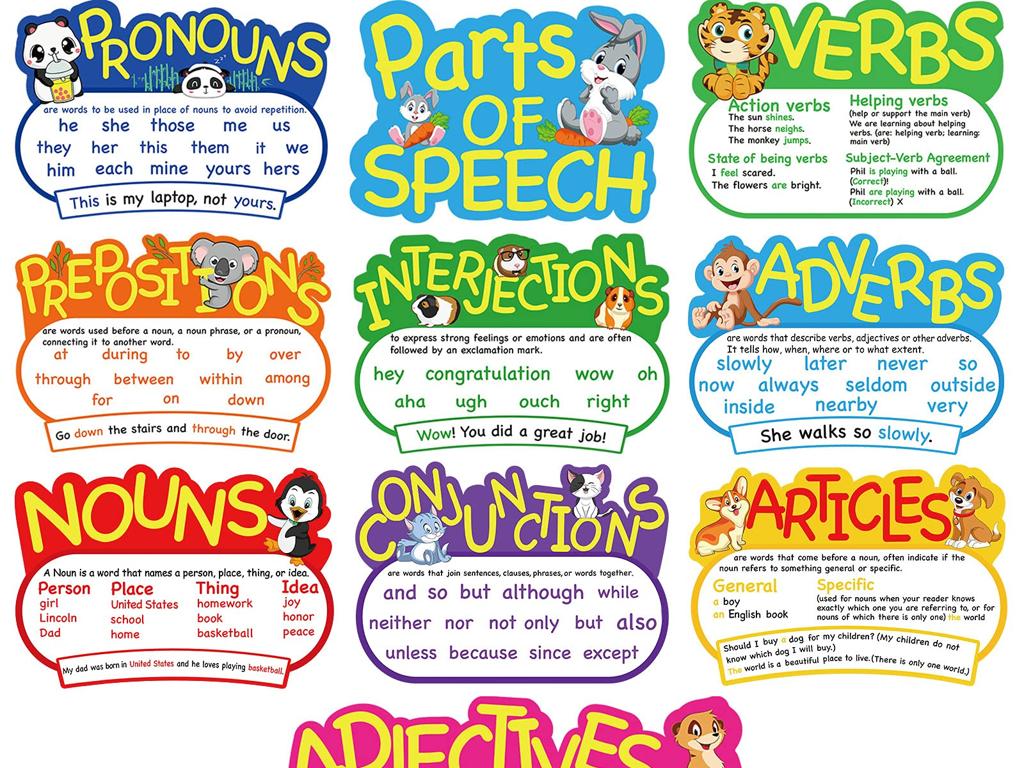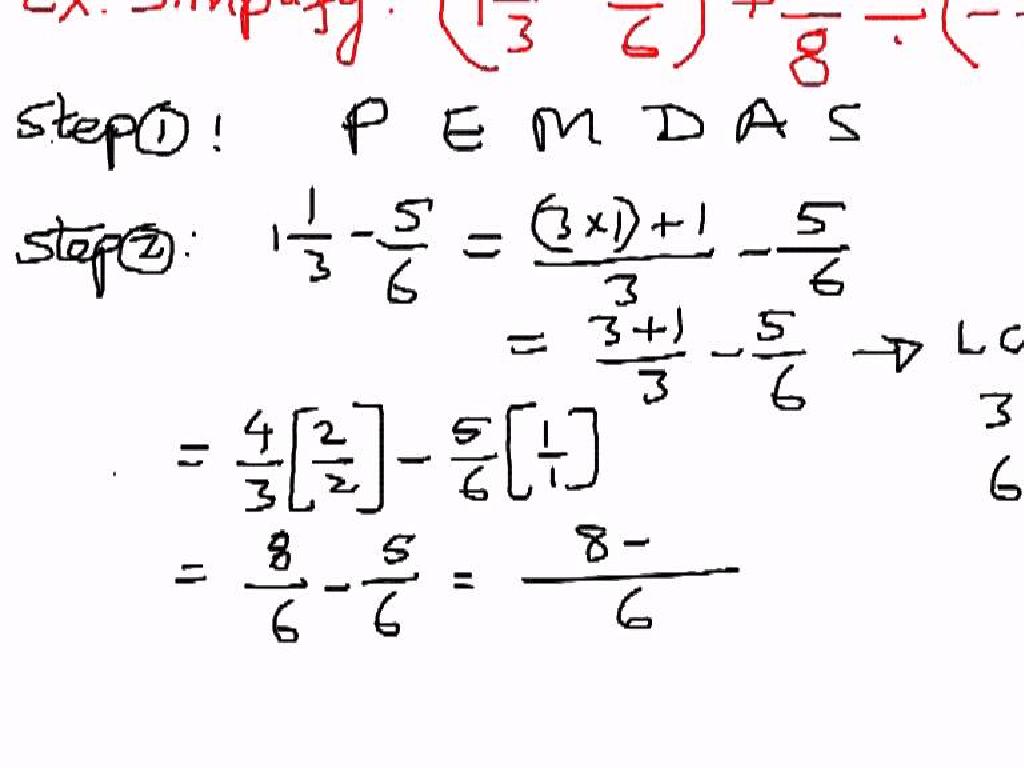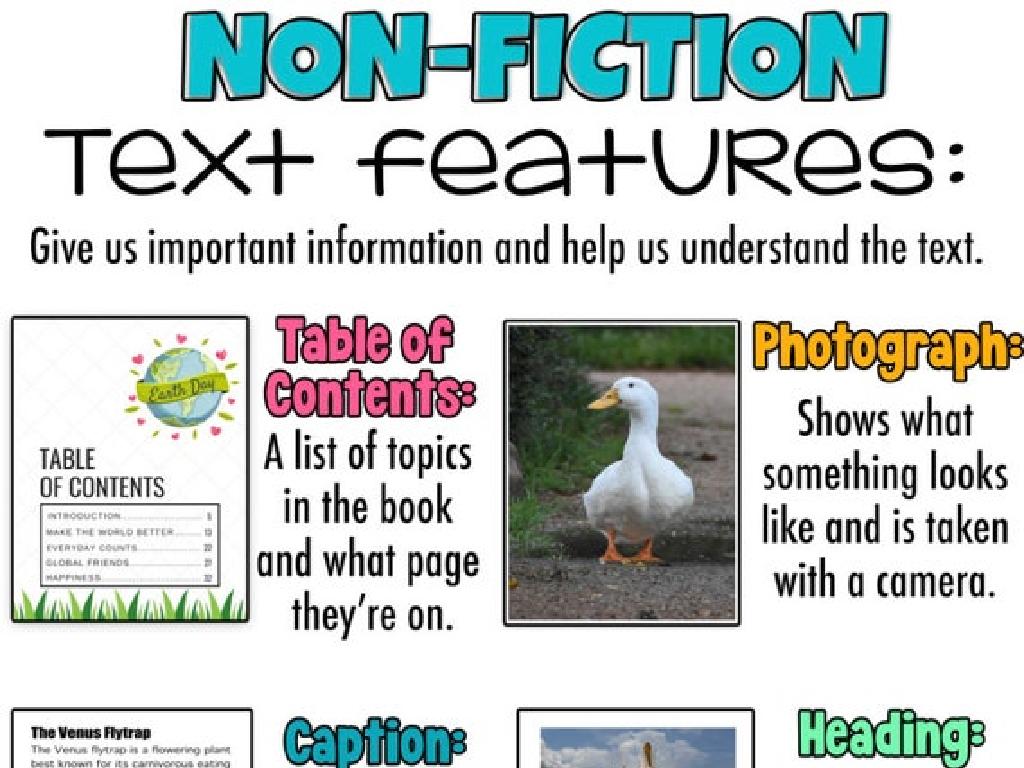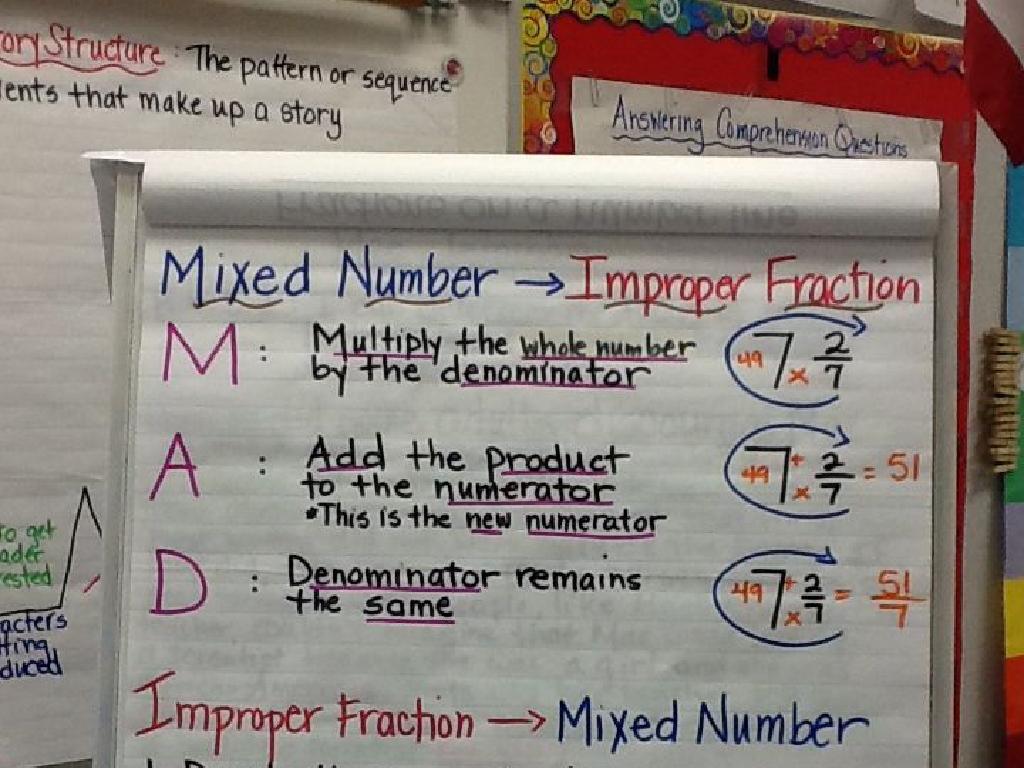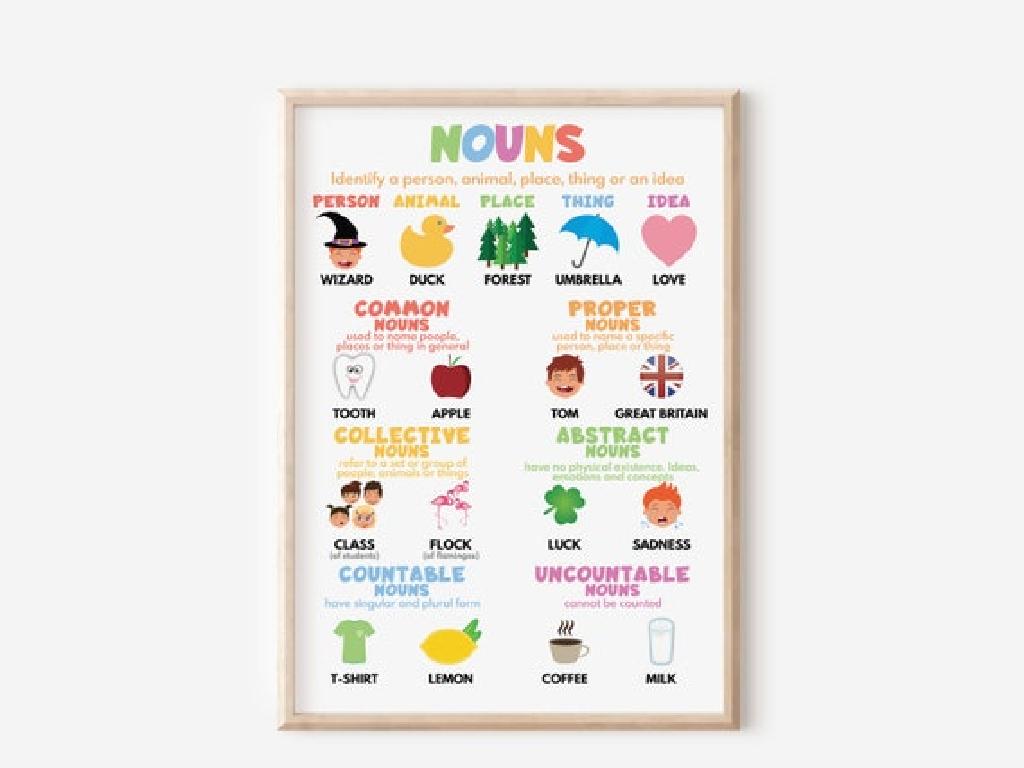Sort Sensory Details
Subject: Language arts
Grade: Fourth grade
Topic: Sensory Details
Please LOG IN to download the presentation. Access is available to registered users only.
View More Content
Exploring Sensory Details
– What are sensory details?
– Descriptions that appeal to our senses
– Discover the five senses
– Sight, sound, smell, taste, touch
– Sensory details in writing
– Using senses to make writing vivid
– Enhancing stories with senses
– Examples: The loud fireworks, the sweet cotton candy
|
This slide introduces the concept of sensory details and their importance in writing. Sensory details are descriptive elements that pertain to the five senses and are used to paint a vivid picture in the reader’s mind. Discuss each of the five senses and how they relate to everyday experiences. Explain how using sensory details can make a story come alive, making the reader feel like they are part of the scene. Provide examples of sensory details for each sense and encourage students to think of their own. In the next class, students can practice adding sensory details to their writing to enhance their storytelling skills.
Exploring Sensory Details in Stories
– What are sensory details?
– Descriptions that appeal to our senses
– Examples in literature
– ‘The cinnamon buns smelled heavenly’ – engages sense of smell
– Significance in storytelling
– They make stories vivid and immersive
– Engaging the senses
|
This slide introduces the concept of sensory details, which are descriptive elements in writing that appeal to the five senses. They are crucial for creating a vivid picture in the reader’s mind, helping them to see, hear, smell, taste, and touch the world of the story. Provide examples from well-known children’s literature where sensory details bring the story to life. Discuss how sensory details enhance the emotional connection to the story and make the experience of reading more engaging and memorable. Encourage students to think of their favorite stories and the sensory descriptions that stood out to them.
Exploring Sensory Details
– Sight: Visual details we see
– Colors, shapes, sizes, and distances
– Sound: Auditory details we hear
– Loudness, pitch, and rhythm of noises
– Smell: Olfactory details we sniff
– Scents and odors that fill our nose
– Taste: Gustatory details we savor
– Flavors our tongue can detect: sweet, salty, sour, bitter
– Touch: Tactile details we feel
– Textures, temperatures, and pain
|
This slide introduces students to the concept of sensory details, which are descriptions related to the five senses. Sensory details help to paint a vivid picture in the reader’s mind, making the reading experience more engaging and realistic. Encourage students to think of examples from their own experiences, like the sight of a rainbow, the sound of rain, the smell of cookies baking, the taste of a lemon, and the touch of a soft blanket. Discuss how these details can enhance storytelling and descriptive writing. In the next class, students can be asked to bring in examples of sensory details from a book they’ve read or a story they’ve written.
Exploring Sensory Details in Stories
– Identifying sensory details
– Sensory details relate to our five senses
– Activity: Find sensory words
– Highlight words that appeal to sight, sound, smell, taste, touch
– Discuss the story’s experience
– How do these words make you feel about the story?
– Understanding the impact
– Sensory words enrich storytelling, making it vivid and engaging
|
This slide introduces students to the concept of sensory details in literature. Begin by explaining that sensory details are words that describe what we see, hear, smell, taste, and touch. These details help us to imagine the story more vividly. For the activity, provide a short paragraph and ask students to highlight or underline words that evoke any of the five senses. After the activity, facilitate a discussion on how these sensory words affect their experience of the story, making it more real and immersive. Emphasize that using sensory details is a powerful way for writers to create a rich and engaging narrative that pulls readers into the world of the story.
Sorting Sensory Details
– Activity: Sort words by senses
– Match words to sight, sound, smell, taste, touch
– Context: Details in many categories
– Some words can describe more than one sense
– Group work: Make a sensory chart
– Work together to organize words into a chart
– Discuss: How senses enhance writing
|
This slide introduces an interactive class activity focused on sensory words. Students will work in groups to sort a list of words into categories based on the five senses. Emphasize that some words may fit into multiple categories, which is a great opportunity to discuss context and how it can change the way we perceive sensory details. After sorting, each group will create a chart of their findings, which will help them visualize and better understand the use of sensory details in language. Encourage students to think about how sensory words can make their writing more vivid and engaging. Possible activities include sorting flashcards, drawing their own examples, or finding sensory words in a favorite book.
Using Sensory Details in Writing
– Incorporating sensory details
– Use the 5 senses to enhance your stories
– Examples of vivid sensory details
– ‘The cinnamon buns smelled warm and sweet’ instead of ‘The buns were in the oven’
– Write a descriptive paragraph
– Use the senses to describe a scene or object in detail
|
This slide introduces the concept of using sensory details to make writing more engaging and vivid. Sensory details involve describing scenes, characters, or actions using the five senses (sight, sound, smell, touch, and taste) to paint a clearer picture in the reader’s mind. Provide examples that show the difference between bland descriptions and those enriched with sensory details. For the individual exercise, prompt students to write a paragraph about a familiar place or experience, encouraging them to include at least one detail for each sense. This activity will help them practice the skill of showing rather than telling in their writing. Offer guidance and support as they explore using sensory language to enhance their storytelling.
Review and Share: Sensory Details
– Revisit the value of sensory details
– Students present descriptive paragraphs
– Share your paragraph with the class
– Discuss the role of sensory details
– How do sensory details enhance writing?
– Reflect on sensory language effectiveness
– Think about how sensory words create vivid images
|
This slide is aimed at reinforcing the importance of sensory details in writing. Begin by reviewing why sensory details are crucial for creating vivid imagery in the reader’s mind. Then, have students share the descriptive paragraphs they’ve written as a practical demonstration of what they’ve learned. Facilitate a class discussion on how the use of sensory details can improve their writing, asking students to reflect on the paragraphs shared and how the sensory language made them feel or what images it conjured up. Encourage students to give constructive feedback to their peers. This activity will help solidify their understanding of sensory details and their application in language arts.
Class Activity: Sensory Scavenger Hunt
– Understand the five senses
– Explore and find sensory items
– Look for items that you can see, hear, smell, taste, and touch
– Record your findings
– Use the worksheet to describe each item with sensory details
– Share with the class
|
This activity is designed to help students understand and identify sensory details through a fun and interactive scavenger hunt. Students will explore their surroundings to find items that correspond to the five senses: sight, sound, smell, taste, and touch. Provide each student with a worksheet to record the sensory details of the items they find. Encourage them to be descriptive and think about how each item appeals to the different senses. After the scavenger hunt, have students share their findings with the class, which will help reinforce their understanding of sensory details and how they can be used in language arts to make writing more vivid and engaging. Possible variations of the activity could include finding items in a storybook, during a nature walk, or within a specific area in the school.
Reflecting on Sensory Details
– Recap on sensory details
– Remember, sensory details involve our five senses
– Sensory details enhance observations
– They make experiences vivid and memorable
– Using sensory details in writing
– Think about how to describe a setting with sight, sound, smell, taste, and touch
– Share your thoughts
|
As we conclude, let’s remember that sensory details involve descriptions related to our five senses. They help us to create a vivid picture in our minds, enhancing our daily observations and making experiences more memorable. Encourage students to reflect on how sensory details can be used in their next writing assignment, perhaps describing a place or an event. Ask them to think about how they can make their readers feel like they are part of the story by using sensory language. Have students share how they plan to incorporate sensory details into their writing, fostering a discussion on the importance of descriptive language.

